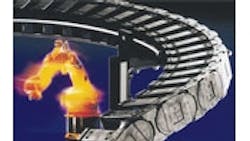Cable carriers: Review of options to handle cables and hoses
___________________
The performance demands on electrical cables and hoses constantly increase. The shrinking size of equipment and facility space often mean cables must bend in a tighter radius. Requirements for higher productivity mean cables and hoses must reliably perform over longer cycle periods.
Cable carriers have often been used to protect these energy transmitting components of a motion system. To meet the increasing demands, though, carrier manufacturers are developing new designs and new materials to help users better manage their cables and hoses.
Handling the bends
The limiting factor in how tightly a carrier can bend is usually the cables or hoses it houses. Each type can only bend so far before they sustain damage, such as conductor breakage, plus cable entanglement and wear from back-andforth motion. The typical minimum bend radius of a high-flex cable is seven to ten times its outer diameter.
The conductors in the cables may be twisted, braided, or bundled for extra resiliency. In addition, the cables and hoses have varying outer diameters, conductor counts, gauges, and transmission properties. Thus, users can select from cables with a small bend radius of five times (or less) the outer diameter.
Harnesses and conduit-support accessories are also available to handle and support cabling. Some vendors offer a complete system, with shelves, separators, mounting brackets, and strain relief components. In general, the conduit carrier should be at least 20% larger than the cable and hose bundle.
Users should also be careful to correctly match the bend radius to the application to prevent a condition known as the polygon effect. This happens when the bend radius is too tight and the carrier crimps as it bends, taking on a polygon shape before it fails. The manufacturer’s application engineers can offer selection advice.
New carrier designs accommodate the twists and turns found in some motion systems, such as articulated robots. In some of these carriers, the design of the linking plates’ inner and outer construction has been modified to increase the flexibility of the carrier along the rotating arc. Often the circumference is also adjustable.
Requiring little space, some of these designs handle circular speeds to 8 mps with a spiral configuration capable of coiling 540 degrees around. Chain width and bend radii are variable, and the conduits are accessible from either side of the carrier.
Going the distance
Travel distances for carrier systems are lengthening. Distances of 700 ft or more are no longer the exception. Depending on weight of the cables (fill weight), unsupported strength, and stability, a carrier can travel short distances without the upper portion rolling so far back, or sagging, that it touches the lower portion. On long travels, however, the carrier will sag until it runs on itself and possibly loses alignment. The usual solution to maintain alignment has been a guide trough. But this adds cost to the system. And, in other cases, there is not enough room in a facility to accommodate it.
For very long travel distances, a rolling carriage system is a solution. Such a system includes a support trolley attached to a fixed track or rails. It keeps loads, except acceleration and deceleration, off the carrier.
The sounds of silence
Noise reduction is becoming a desired feature in cable carriers, especially in assembly and automotive industries. “Such carriers are addressing an issue many did not realize was an issue for customers,” says Halley Lavenstein, a spokesperson at igus inc.
A feature of one noise-reduced carrier is a modified stop-dog in each link. The stop-dog is a segment on the sides of each link that acts as a brake, easing the speed of impact between links as they glide through the bend radius. In some applications, this modification reduces the overall machine noise level by 50%.
Proper material selection, such as choosing carriers made of plastics rather than metal, is another way to reduce noise. Though standard plastics work for the majority of applications, manufacturers are exploring new plastics to enhance wearability. Delrin and PTFE are increasingly being used. Ultrahigh molecular weight (UHMW) plastic is another choice.
“This plastic enhances abrasion resistance and provides excellent wear surfaces in critical applications,” Says Stephan Achs, executive vice president and general manager at KabelSchlepp America. Manufacturers are also exploring polymer blends to deal with specific application demands.
Improved designs let carriers be used in outdoor and heavy applications, increasing carrier strength by 50%. This lets the carriers run unsupported on their sides, withstanding side loads.
Carriers are also available in combinations of metal and plastic.
Other features carriers increasingly offer include improved resistance to dirt and other contaminants. Overlapping links, for example, create a seal against the environment, protecting cabling from oil, metal cutting chips, and other elements.
Modular design lets users create custom configurations from standard components. These designs may also offer innovative access to the cabling. Because of the modularity, users may be able to do much of the installation themselves.
Lastly, users may want to examine the service capabilities of a potential supplier. Manufacturers are increasingly using their service to differentiate themselves from the competition.
